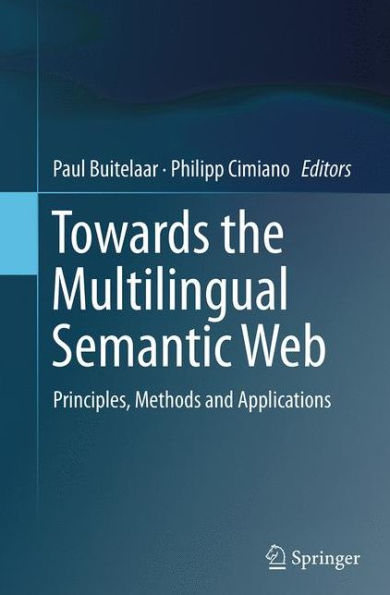The Multilingual Semantic Web as envisioned in this volume will support the following functionalities: (1) responding to information needs in any language with regard to semantically structured data available on the Semantic Web and Linked Open Data (LOD) cloud, (2) verbalizing and accessing semantically structured data, ontologies or other conceptualizations in multiple languages, (3) harmonizing, integrating, aggregating, comparing and repurposing semantically structured data across languages and (4) aligning and reconciling ontologies or other conceptualizations across languages.
The volume is divided into three main sections: Principles, Methods and Applications. The section on “Principles” discusses models, architectures and methodologies that enrich the current Semantic Web architecture with features necessary to handle multiple languages. The section on “Methods” describes algorithms and approaches for solving key issues related to the construction of the Multilingual Semantic Web. The section on “Applications” describes the use of Multilingual Semantic Web based approaches in the context of several application domains.
This volume is essential reading for all academic and industrial researchers who want to embark on this new research field at the intersection of various research topics, including the Semantic Web, Linked Data, natural languageprocessing, computational linguistics, terminology and information retrieval. It will also be of great interest to practitioners who are interested in re-examining their existing infrastructure and methodologies for handling multiple languages in Web applications or information retrieval systems.
The Multilingual Semantic Web as envisioned in this volume will support the following functionalities: (1) responding to information needs in any language with regard to semantically structured data available on the Semantic Web and Linked Open Data (LOD) cloud, (2) verbalizing and accessing semantically structured data, ontologies or other conceptualizations in multiple languages, (3) harmonizing, integrating, aggregating, comparing and repurposing semantically structured data across languages and (4) aligning and reconciling ontologies or other conceptualizations across languages.
The volume is divided into three main sections: Principles, Methods and Applications. The section on “Principles” discusses models, architectures and methodologies that enrich the current Semantic Web architecture with features necessary to handle multiple languages. The section on “Methods” describes algorithms and approaches for solving key issues related to the construction of the Multilingual Semantic Web. The section on “Applications” describes the use of Multilingual Semantic Web based approaches in the context of several application domains.
This volume is essential reading for all academic and industrial researchers who want to embark on this new research field at the intersection of various research topics, including the Semantic Web, Linked Data, natural languageprocessing, computational linguistics, terminology and information retrieval. It will also be of great interest to practitioners who are interested in re-examining their existing infrastructure and methodologies for handling multiple languages in Web applications or information retrieval systems.

Towards the Multilingual Semantic Web: Principles, Methods and Applications
333
Towards the Multilingual Semantic Web: Principles, Methods and Applications
333Paperback(Softcover reprint of the original 1st ed. 2014)

Product Details
| ISBN-13: | 9783662515389 |
|---|---|
| Publisher: | Springer Berlin Heidelberg |
| Publication date: | 11/28/2015 |
| Edition description: | Softcover reprint of the original 1st ed. 2014 |
| Pages: | 333 |
| Product dimensions: | 6.10(w) x 9.25(h) x (d) |
